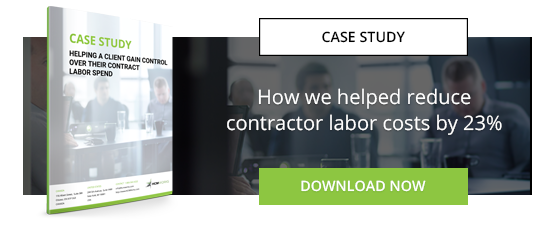Lowering Indirect Procurement Costs with Better Technology and Best Practices
The procurement function in an organization can be split into 2 areas. Direct procurement involves acquiring raw materials and goods for production, while indirect procurement involves purchasing services and supplies that are required for everyday operation. The largest cost component by far within your indirect procurement costs will be people, and more recently, contingent workers (also known as external, non-permanent workers).
A lot of companies underestimate how costly procuring a contingent workforce can be; with the growing number of advantages of the on-demand gig economy it is clear to see why companies are utilizing these assets, but they do present potential procurement challenges.
Procurement and Contingent Workforces
Contingent, or non permanent workers, don’t tend to be hired through the standard methods such as an HR department. They are often hired on a departmental or even project level. In addition to being paid differently, contingent workers fall under different rules and tax rates.
As contingent labor is a growing market, managing your indirect spend effectively can become expensive without the right industry expertise. It can be easy to overlook certain invisible costs, when a procurement department is focusing on finding the required talent at a fair market rate for a current project. Invisible costs can come in the form of compliance, business value, risk management and additional considerations that could become costly over time.
With indirect procurement becoming more widely recognized as an opportunity for cost control, a lot of companies still lack proper understanding of the value of cost-effective and efficient procurement of workforce labor.
Managing Procurement Costs
Having the right workers in place for projects and the ability to on-board them quickly is important, but, regardless of your situation as a company, you should always be trying to minimize costs where you can.
It is crucial to track and analyze each dollar during your procurement process, as it is impossible to control what you can’t see, invisible and rogue cost could be impacting your bottom line.
If you can effectively manage and track your indirect procurement spend then you are able to effectively reduce your costs. Companies on average, can save between 15-20% on their indirect procurement costs.
With larger companies most likely spending millions on their contingent workforce, even a small percentage of savings would create a significant cost reduction.
Procurement Technology
Another important way to help reduce your procurement costs is to use technology to procure your workforce. With an effective e-procurement software, you can customize what you are looking for to access the best talent, apply different hiring restrictions and rules for projects, set spend authorizations and freezes, manage and track all your workers and gain visibility of your workforce and spending.
As a rule of thumb, the more you know about your spend on indirect procurement, the better you can control it and the better you can keep costs down. With the use of technology you can automate and streamline the process to increase your efficiency.
Total Workforce Management Best Practices
Your procurement technology should be part of a total workforce management solution that goes further than just project management and cost control. Having a good solution for this will greatly reduce your costs, your total workforce management solution should have:
- A clear strategy with your companies ambitions, areas of concern and goals
- A shift to considering the worker’s overall value to the company as opposed to pure cost play
- A cross-departmental sharing of responsibilities and roles
- Proper transformation management with someone designated to be in charge of driving change in your procurement process
- A unified information hub which allows for greater workforce visibility, spend control and cohesion
- A collection and analysis of management data and talent acquisition
- The right tools for sharing and visualizing insights about the pros and cons of your procurement process
Outsourcing Your Procurement
A lot of companies look to third-party organizations to look after their indirect procurement resources, processes and infrastructure. Outsourcing allows for industry experts to reduce your costs, analyse your methods, locate and fix problems and develop more efficient processes. Outsourcing your indirect procurement is a key task in reducing your spend on contingent labor.
HCMWorks advisors are experts in contingent workforces and contingent labor. Contact us today to discuss your organization’s unique contingent needs and challenges. To find out how we’ve helped clients before check out the case study below.



